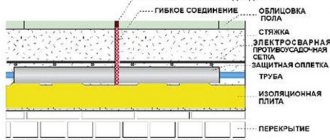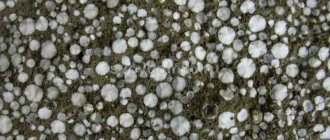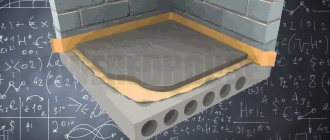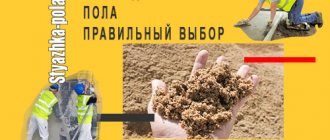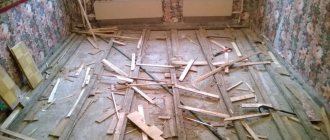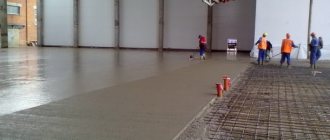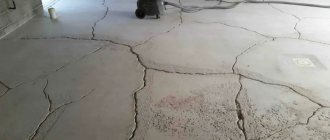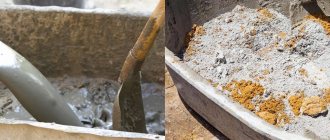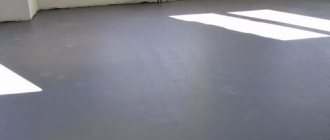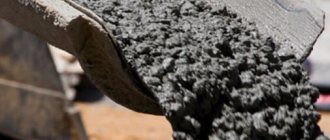Sand plus cement
Screeding a heated floor with your own hands is mainly done with a mixture of cement and sand, which involves mixing one part of cement and three parts of sand. During mixing, water is added to the solution. Its quantity depends on the consistency of the solution, and the thickness of the solution depends on the height of the screed above the heated floor.
An alternative option involves purchasing a ready-made mixture of sand and cement. This option is quite expensive, but more effective, as it improves the quality of the screed. The finished solution requires the addition of a plasticizer, based on 9 parts of the solution, 1 part of the plasticizer. A screed for heated floors, the composition of which is not limited to sand and cement, has improved performance characteristics.
Thanks to plasticizer additives:
- the cement mixture becomes more plastic, which prevents cracks from appearing in the screed;
- the efficiency and uniformity of heating increases due to improved thermal conductivity;
- the thickness of the screed for water heated floors can be reduced from 5 cm to 3 cm;
- The screed hardening process occurs much faster.
And yet, a simple cement-sand screed is not strong enough under heating conditions. Therefore, there is every reason to complicate it.
Features of concrete mortars for screed
The installation of heated floors must be done correctly. The strength of floors depends on the quality of concrete preparation. To ensure normal warmth in the home, the temperature inside the screed should remain around 50 °C, and on the floor covering should drop to 30-35 °C.
Such frequent changes in temperature conditions lead to the destruction of the heated floor:
- microcracks begin to appear in the flooring system, the size of which gradually increases;
- air in cracks causes a decrease in the thermal conductivity of the floor and heating efficiency, since heat is lost through the cracks;
- an increase in cracks leads to distortion and deformation of the cement layer, as a result of which the heating elements begin to be damaged;
- the use of high-voltage wiring can lead to electric shock, and if a water pipeline is laid, then deformation of the pipes can cause flooding of the lower floors.
To prevent such undesirable consequences from a warm water floor, the concrete solution for screeding a heated floor must be prepared so that it differs:
- minimal porosity. The density of the structure increases thermal conductivity, resulting in improved heating efficiency;
- low tendency to form cracks in concrete. In addition to increasing heating efficiency, the absence of cracks eliminates deformation and damage to pipes;
- increased strength so that when residents move across the floor or install furniture, the concrete surface remains intact and does not crack.
We recommend: Should I use penoplex for heated floors?
Therefore, the solution for concrete screed must be prepared in the correct proportion of cement, water and sand.
It must be remembered that a short setting time of the solution leads to uneven hardening, since residual stresses arise while the concrete surface is wet in one part and dry in the other.
The result is a low-quality screed, which will not only reduce the efficiency of heating, but can lead to emergency consequences and unexpected material costs.
Concrete
The composition of the screed for water heated floors is not limited to the use of cement, sand, plasticizer and water.
It is possible to use two types of concrete composition for pouring heated floors:
- For this composition, cement grade M-300 and not lower is used. To mix such a concrete mixture with your own hands, you will need screening, which includes small fractions of crushed stone and sand. In addition to screening, a plasticizer and water are added to the solution. The height of the screed for a water heated floor when using a concrete mixture can be within 2-4 cm, depending on the design requirements.
- This type of concrete mixture is designed to use crushed stone instead of screenings, which will significantly strengthen the screed for a water floor. In this case, the following proportions are used: cement - 1 part, sand - 3.5 parts, crushed stone - 4 parts, plasticizer and water. The minimum screed for a water-heated floor in this case is limited only by the thickness of the finishing layer (for more details: “What is the minimum thickness of a floor screed - standards and rules”).
As advice, we can offer the following kneading option: abandon manual kneading in favor of using an electric mixer for construction purposes.
Dry mixes
Directly for such cases, the manufacturer produces specialized dry solutions.
They consist of:
- Portland cement as the basis of a dry mixture.
- Sand of various fractions for better adhesion.
- A complex of specialized additives and additives that improve thermal conductivity.
- Additives that compensate for thermal expansion.
- Defoamer that minimizes the formation of air bubbles.
Before mixing the solution, add water to it. Its quantity depends on the technological characteristics of the dry mixture and is indicated on the packaging. After this, the mixture is stirred until smooth. In this case, you should pay attention to the instructions for adding liquid. If you add too little or too much water, some of the special additives may lose their properties.
Ready solution:
- has a medium-thick consistency without releasing liquid;
- not afraid of temperature changes;
- sets within seven days;
- resistant to cracking.
When using such a solution, the minimum thickness of the screed for a water heated floor can correspond to 5 mm. If the installation of a water heated floor screed is carried out before laying the heated floor, then the installation of such a floor can be done by laying pipes directly into the screed. The consistency of the solution will allow the pipes to be pressed into the mixture, where they will be securely fastened without the use of fasteners.
Mixture composition
Cement screeds for pouring are wet and semi-dry:
- the wet type is a conventional cement-sand or concrete composition;
- The semi-dry type of mixture contains, in addition to sand and cement, plasticizers and other property modifiers.
Wet type
Wet type cement screed is prepared by adding clean river sand to the cement. This method is considered the simplest for closing a warm water floor and its heating pipes; it does not require special skills or special equipment.
To mix the solution, you just need a large container and a hammer drill, so you can do without a concrete mixer.
If finances allow, you can use a ready-to-use dry mortar, developed in compliance with the proportions of additives, sand and cement: you just need to mix the mixture with water according to the instructions.
Wet-type mixtures have a classic composition: cement mortar consists of cement and quarry sand in a ratio of 1:3 or 1 to 4.
By adding water, you get a liquid plastic consistency, which can then be easily leveled after pouring and get a smooth surface. If the base is uneven, fine expanded clay is added to the concrete solution.
To improve the strength of the screed, during the preparation of the cement mortar, plasticizers are added, which can be liquid or dry. The standard amount of such additives is 0.8 liters per 1 sq.m. screeds.
Cement should be used grade 300-400 for pouring floors in residential premises. Low grade cement will not provide a strong and durable foundation.
We recommend: Features of Fenix heated floors
The advantage of wet screeds is the simplicity and ease of preparation and the availability of components.
The advantage of such a screed is the fact that it is quite thin on a flat surface, therefore, the volume of the room does not decrease with it.
Screed for water-type underfloor heating is performed for several purposes. Most importantly, it protects the pipes from external mechanical loads, protects them, prevents wear, and helps maintain the tightness of the pipes.
On the other hand, the wet screed correctly distributes the heat exchanger, which operates according to the following principle: the air in the rooms is heated according to the following scheme:
- water pipes emit heat;
- then heat is transferred to the concrete layer;
- in turn, the concrete screed transfers thermal energy to the floor covering, and the air in the room gradually becomes warm and comfortable for residents.
Another advantage of concrete screed: due to its heat-retaining properties, such a layer takes a long time to cool down, which provides significant fuel savings.
Despite its popularity in construction work, wet screed has its drawbacks.
It is not recommended to lay insulated linoleum or laminate underlay on top of concrete floors, which are considered heat-insulating materials and can reduce the efficiency and effect of heated floors. The best options for finishing flooring over a concrete layer are porcelain stoneware, tiles and clinker.
The solution of such a screed takes a long time to dry; the process can take from 15 to 30 days. Until all the liquid has evaporated from the concrete, the surface has reached the desired state of dryness, so that you can start finishing it, you have to wait a long time.
Semi-dry type
The semi-dry type of screed has a short hardening time for the solution, since less water is used in the preparation process of this type. The addition of special additives leads to improved performance of the screed.
In addition to plasticizers, when laying a heated floor, fiber is added, which comes in the form of thin organic or mineral fibers. They increase the strength of mortar from semi-dry mixtures and reduce the formation of cracks in the cement screed.
We recommend: What are the advantages of Heat plus underfloor heating?
Semi-dry screed dries quickly, it almost does not crack.
Semi-dry mixtures are prepared in two stages.
Take cement and mix it with sand in a ratio of two to three. For example, 20 kg of cement and 10 kg of sand, then add 30 g of fiber fiber to the mixture for every kilogram of cement.
Fiber fiber must be added in small portions, as it is difficult to mix.
After thoroughly mixing the components, water is added to the mixture in portions (up to 8 liters for the specified components). The resulting solution is left to settle for 20–30 minutes.
The preparation of the second portion is carried out without cement with the inclusion of the following components:
- sand 20 kg;
- fiber fiber 25;
- 4 liters of water. 1:5:6.
Mix everything until a homogeneous mass is obtained.
Pouring a semi-dry screed is considered a rather complex process, in which it is necessary to use a concrete mixer.
Stirring by hand is very difficult; you need a vibrating plate. If you lack the skills, you can ruin the whole job. Semi-dry screed is suitable for film or cable heating.
It is better to avoid doing the semi-dry type of screed with your own hands.
You can do the installation of floors with water or electric heating yourself - the process is not complicated, but only for those who have experience working with cement or other solutions for heated floors, and are also well versed in electricity.
If you don’t have the skills, then you need to turn to specialists. Installing a heated floor requires responsibility; violation of installation technology can quickly lead to undesirable consequences. Before installation begins, you must purchase high-quality materials; it is not recommended to skimp on them.
In Moscow and the Moscow region you can order any type of mortar for underfloor heating screed.
- Related Posts
- What are the advantages of a heated metal-plastic floor?
- How to choose a wire for a heated floor?
- Features of Korean heated floors
- How to install a film heated floor?
- How are PEX pipes connected for heated floors?
- How does radiant floor heating work?
Installation
The screed on a warm floor is characterized by the presence of some features.
The process of pouring screed onto a heated floor takes the following steps:
- Along the entire perimeter of the room, at the joints of the floor and walls, edge tape is glued. It is designed to compensate for the thermal expansion of concrete.
- The minimum height of the screed is calculated with the corresponding marks. The overall height of the heated floor will depend on the nature of the solution used.
- The appropriate beacons are installed according to the height of the heated floor.
Measures are taken to prevent cracks from occurring.
